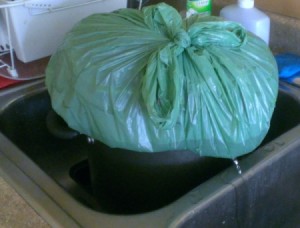 I recently got about 15 pounds of fresh green beans from a friend. She pickles them and gives away the shorter ones. I didn't have a colander big enough and wanted to get them processed.
I recently got about 15 pounds of fresh green beans from a friend. She pickles them and gives away the shorter ones. I didn't have a colander big enough and wanted to get them processed.
So I found a new garbage bag, and filled it with the beans and water. After sitting for about 10 minutes, I simply poked a hole or two in the bag and drained the water. They were clean and all together to bag and freeze.
It sure did make quick work of my project and I had fresh beans that night. Still eating them, in fact, as you can take out as much or as little as you want. N-JOY!
Source: Just a big project and a tiny kitchen.
This page contains the following solutions.
Whatever you do, don't use anti-bacterial soap! You don't want any residue in you, and it's not that good anyway, and in time causes resistance in bacteria.
Here are the questions asked by community members. Read on to see the answers provided by the ThriftyFun community.
What can I use to clean fruits and vegetables?
Nancy from Tucson, AZ
On apples and cukes and potatoes that I leave skin on, I use a sprinkle of baking soda and plain water. I just use my hands to "scrub" and then rinse.
I wash all fruits and vegetables with soap and water! I fill the sink and wash them like you would your dishes. I love to eat the skins on potatoes, so I scrub them well.
Vinegar is good and when I can I use antibacterial dishwashing detergent and water.
Thanks so much,
Nancy from Tucson
I just rinse them with water. If I am making mashed potatoes I just peel them or for bake I just scrubbed with a brush if too much dirt is on them.
What is the latest guidelines about washing fruits and vegetables before using?
By JoCarmen27 from Pittsburgh, PA
This is from the ThriftyFun Archives and is timeless wisdom:
-Wash fruits and vegetables only before eating. If you wash the item before storage, it will spoil more quickly.
-The best way to wash the fruit or vegetable thoroughly is by gently rubbing the produce item under clean running tap water.
-If the fruit or vegetable is firm enough (like potatoes and squashes) and the skin will be eaten, then a scrub brush should be used to clean the surface.
-All fruits and vegetables should be washed even when the skin and rind are not eaten, such as oranges and melons.
-You do not need to use detergents or bleaches when washing any fruits or vegetables as they may stay on the surface and might be absorbed into the produce. Detergents and bleaches are not intended for use on foods and consuming them on fruits and vegetables may make you sick.
-Commercial produce sprays or washes are available in some supermarkets. However, governmental agencies do not recommend these sprays or washes. No washing method completely removes or kills all microbes, which may be present on the produce. Washing produce with clean tap water is adequate.
-Take off the outer leaves of leafy vegetables such as lettuce and cabbage before washing. Rinse leaves individually under running tap water and place in a salad spinner to dry.
-Cut out any bruised areas of the produce because bacteria may grow and cause illness if consumed.
-Keep raw meats separate from fresh fruits and vegetables. Use different cutting boards, knives, and utensils when preparing meals.
-Always wash cutting boards, knives, utensils, and your hands after handling raw meats and before handling fresh fruits and vegetables.
-Be sure to keep your refrigerator clean and cold.
-Wrap or cover any fruits or vegetables that you have cut and store them above raw meats.
ThriftyFun is one of the longest running frugal living communities on the Internet. These are archives of older discussions.
Tips for washing fruits and vegetables. Post your ideas.